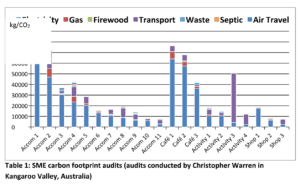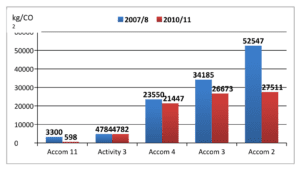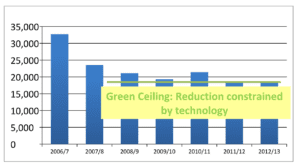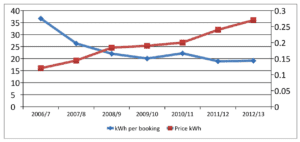The Green Ceiling
Savings that are early ‘low hanging fruit’ hid the challenges on longer time savings
Christopher Warren, Progamme Director, My Green Butler
Tourist accommodation has three primary focus areas for resource management: design & technology, management practices and customer behaviour. Design & technology and management practices have been the primary area of activity with only low level initiatives directly targeting guests e.g. linen and towel reuse. The savings from design & technology improvements are estimated to be 20-30% 1, indicating they will be insufficient to negate the sectors’ growth both to reach the WTTC target a 50% carbon emissions reduction target by 2035 2 nor reach the Paris Agreements Zero Net Emissions by in just over 30 years.
The initial savings are easy reductions
The focus for resource efficiency and reduction in carbon emissions has been with energy and in particular electricity. For example electricity usage for Small Medium Tourism Enterprises (SMTE) represents the primary contribution to carbon emissions (Table 1). Initial focus in this area has led to easy savings through replacement of light bulbs and more efficient white goods (Table 2). Businesses like ‘Accom 2’ cut electricity consumption by nearly 50%.


Table 1: SME carbon footprint audits (audits conducted by Christopher Warren in Kangaroo Valley, Australia)
Table 2: Electricity savings achieved through ‘easy’ first initial action (audits conducted by Christopher Warren in Kangaroo Valley, Australia)
However, further savings through technology proved much harder to achieve and require higher levels of investment and longer time for a return. This makes considering staff and guest pro-environmental behaviour change all the more valuable and relevant. Table 3 shows a case study example of a tourist accommodation business with four cottages, an office and manager’s residence. The figures are in kWh and include the entire business for the financial years from 2006/7 till 2012/13. The manager applied energy saving practices and replaced technologies over a seven year period. This resulted is a 45% reduction in electricity. Yet only the initial years delivered the real reduction. This business reached a ‘Green Ceiling’ where auditing and eco-efficient technology could not further reduce electricity. The overall consumption in the last four years is reasonably flat. While guests were notified of the businesses efforts there was no way of identifying if guests had changed consumption. Certainly the gas and water bills did not show any change over this period.

Green Ceiling: Reduction constrained by technology and ‘normal’ practices
Table 3: Seven year electricity consumption of one tourist accommodation business
Easy Eco Savings are only short term financial savings
Table 4 shows the seven year electricity usage of our case study business compared to price of electricity in NSW Australia. The accommodation business saw per booking energy usage drop from 36kWh to 19 kWh. However, the price of electricity rose over the same period so there was no additional cost saving. This shows how operators may tend to not ‘feel’ any benefits.

Table 4: Electricity Usage compared with Electricity Prices
Meanwhile over the same period guest expectations continue to demand ever higher energy entertainment facilities and rising temperatures from extreme weather events in Australia placed additional pressure on energy and water demand. The early eco-efficient technologies did not enable the operator to counter these additional human needs. While they helped to reduce initial consumption, there were not sufficient in themselves to counter behaviour due to society changes and Climate Change. Therefore further strategies to reduce usage need to be deployed which directly involve a change in management practice and guest behaviour so that social change and Climate Change can be more precisely considered and business can break through the Green Ceiling.
References
- Becken (2012) Operators’ Perceptions of Energy Use and Actual Saving Opportunities for Tourism Accommodation
- World Travel & Tourism Council (1999) http://www.wttc.org/about/history/


